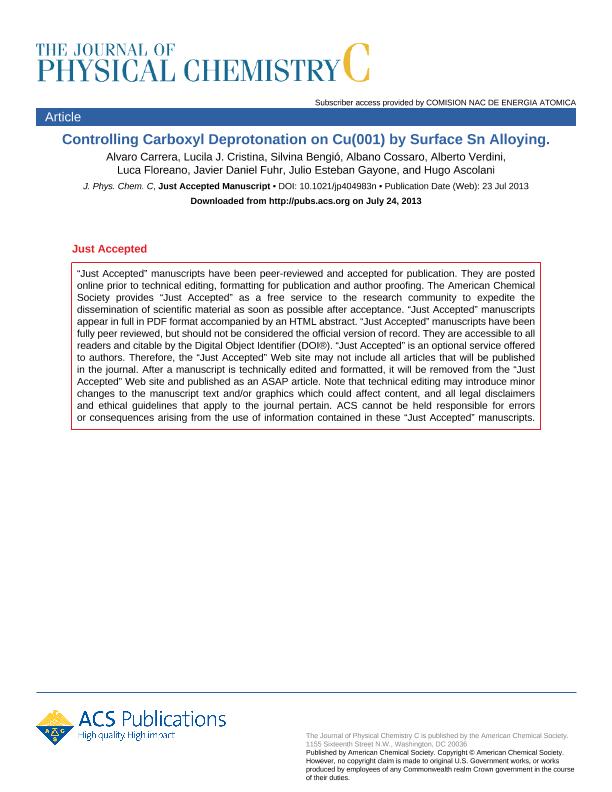Artículo
Controlling Carboxyl Deprotonation on Cu(001) by Surface Sn Alloying
Carrera, Alvaro Daniel ; Cristina, Lucila Josefina
; Cristina, Lucila Josefina ; Bengió, Silvina
; Bengió, Silvina ; Cossaro, A. ; Verdini, A. ; Floreano, L.; Fuhr, Javier Daniel
; Cossaro, A. ; Verdini, A. ; Floreano, L.; Fuhr, Javier Daniel ; Gayone, Julio Esteban
; Gayone, Julio Esteban ; Ascolani, Hugo del Lujan
; Ascolani, Hugo del Lujan
 ; Cristina, Lucila Josefina
; Cristina, Lucila Josefina ; Bengió, Silvina
; Bengió, Silvina ; Cossaro, A. ; Verdini, A. ; Floreano, L.; Fuhr, Javier Daniel
; Cossaro, A. ; Verdini, A. ; Floreano, L.; Fuhr, Javier Daniel ; Gayone, Julio Esteban
; Gayone, Julio Esteban ; Ascolani, Hugo del Lujan
; Ascolani, Hugo del Lujan
Fecha de publicación:
08/2013
Editorial:
American Chemical Society
Revista:
Journal Of Physical Chemistry C
ISSN:
1932-7447
Idioma:
Inglés
Tipo de recurso:
Artículo publicado
Clasificación temática:
Resumen
We find that for adsorbed terephthalic acid (TPA) molecules surface Sn alloying deactivates the Cu(001) surface by decoupling the adsorbed molecules from the substrate. This effect is investigated for the case of the 0.5 ML phase of the Sn/Cu(001) surface alloy by applying fast X-ray photoemission spectroscopy, scanning tunneling microscopy, near-edge Xray absorption fine structure spectroscopy, and density functional theory calculations. The experimental results conclusively show that the deprotonation reaction of the carboxyl groups occurring in the clean Cu(001) is fully inhibited on this Sn/Cu(001) surface alloy, which allows the molecules to form two-dimensional arrays stabilized by [OH···O] hydrogen bonds. The formed arrays exhibit a crystal structure that is practically indistinguishable from that theoretically obtained for unsupported TPA sheets, suggesting an extremely weak molecule/substrate interaction. This is supported by DFT calculations of the adsorption energy landscape of the TPA sheets formed on the Sn/Cu(001) template: the lateral variation of the adsorption energy (corrugation) is estimated to be less than 0.2 eV, with an adsorption energy per molecule in the range 1.6−1.8 eV and a contribution of each double [OH···O] bond of 1 eV. Finally, the performed thermal desorption experiments show that the TPA sheets remain stable on the surface alloy until their desorption. From these experiments, a value of 1.5 eV was determined for the desorption energy barrier, which is consistent with the important contribution of the [OH···O] bonds to the stability of the sheets as theoretically predicted. The results reported in this study suggest that a gradual activation of the interaction between the TPA molecules and the Cu(001) surface will also be obtained for decreasing Sn coverage.
Palabras clave:
Surfaces
,
Alloys
,
Autoassemblies
,
Hydrogen Bonds
Archivos asociados
Licencia
Identificadores
Colecciones
Articulos(CCT - PATAGONIA NORTE)
Articulos de CTRO.CIENTIFICO TECNOL.CONICET - PATAGONIA NORTE
Articulos de CTRO.CIENTIFICO TECNOL.CONICET - PATAGONIA NORTE
Citación
Carrera, Alvaro Daniel; Cristina, Lucila Josefina; Bengió, Silvina; Cossaro, A. ; Verdini, A. ; et al.; Controlling Carboxyl Deprotonation on Cu(001) by Surface Sn Alloying; American Chemical Society; Journal Of Physical Chemistry C; 117; 8-2013; 1-1
Compartir



